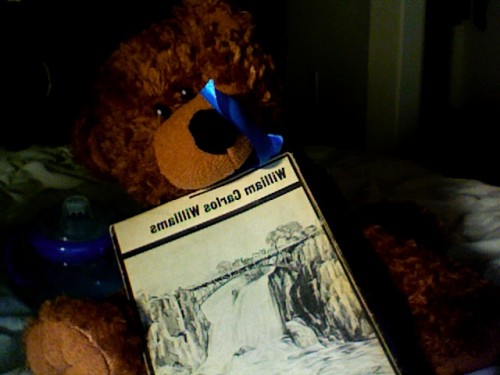Some Must Read Books
a.k.a. “Playing catch up with the stacks [5].”
In this series, I share with you a stack of my recently acquired and most anticipated reading materials. In 2012 I did one of these in November, August, and March, and in 2011 I did one in May.
Once again I have a heaping pile of awesome-looking unread materials just waiting to be experienced…
Bride Stripped Bare
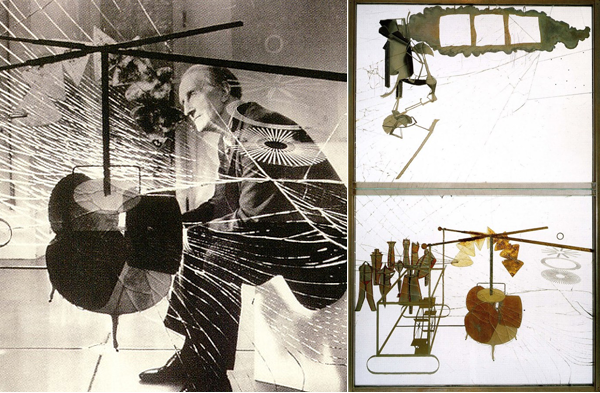
Between 1915 and 1923, Marcel Duchamp tedious arranged seemingly arbitrary shapes concerning a myth about a bride and her nine bachelors that he would refuse to convey to others. The Bride Stripped Bare by Her Bachelors, Even leaves us with an eerie Avant-garde cartoon embedded between panes of cracked glass which conform to a unique “mechanomorphic” law of physics, whose notes began in 1913, he was to incorporate in The Green Box (1934), a limited edition (of 320) scrap heap compilation of its conception and execution — though let not the word “edition” and the auspices of printing fool you; he produced each one by hand. The cracks in the glass are ostensibly controlled, which may explain why he was both insane and spent eight years to create it. None is this is really meant to make any sense. Duchamp’s self-enthralled solipsisms juggle meaning and nonsense, until the viewer is just left to stare. If there is a God, he too must be a fan: In 1926, the Brooklyn Museum accidentally broke the art piece in transport, making the cracks worse (via the actual laws of physics). Marcel, unfortunately, was not there to repair what he described as a “hilarious picture” in the first place.
How to Think More About Sex
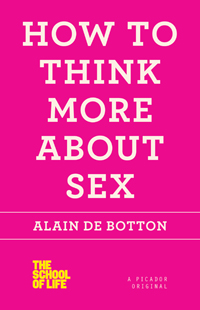 How to Think More About Sex
How to Think More About Sex
by Alain de Botton
Picador, December 2012
192 pages / $16 Buy from Picador or Amazon
In the middle of Michel Houellebecq’s The Elementary Particles, the narrator makes one of many comparisons between sex and the free market:
While Houellebecq has been derided by some as misogynistic and bleak, it is clear that upon reading Alain de Botton’s How to Think More About Sex, a slim volume that should have been titled How to Think More About Heteronormative Sex, the two would be in agreement about at least one thing: as those with partners age, both in their relationships and biology, individual desire for sex decreases until finally, death. In one of the more interesting sections of the book (the other being on pornography,) one of the first in Picador’s “The School of Life” series, de Botton repudiates the assertion first made by the Masters & Johnson study that states in order for a marriage to be successful, sex should be a constant. Ignoring this trend that was later capitalized upon by sex therapists and then pharmaceutical companies, de Botton argues that a decrease in our sex drive and the quality and quantity of sex is purely normal and is a “necessary comprise of long-term love.”
March 15th, 2013 / 12:00 pm
The Kmart Belles Lettres Conference Summation
As many are already absolutely aware, beginning on March 6 and ending on March 9 there was a literary conference — sponsored by Bambi Muse and Fox News — of sparkly specialness. That literary conference — the Kmart Belles Lettres Conference — was clamorous, and clamor commands a summary. So here is a summary!
March 6 (Day 1):
Most of the attendees were in a foul mood for the first day. Edie Sedgwick, for one, lost her fur in a cab on the night before and refused to mingle with anyone, even the sharp society poet Edith Sitwell. Sitwell tried to offer Edie a coup of tea, but Edie insisted that no one speak to her about anything unless it was directly related to the recovery of her fur coat.
So, instead Sitwell started a conversation with none other than Baby Adolf, the first Bambi Muse baby. Here’s a snippet of their chat:
The Revolution is Never Televised: Robbe-Grillet’s PROJECT FOR A REVOLUTION IN NEW YORK
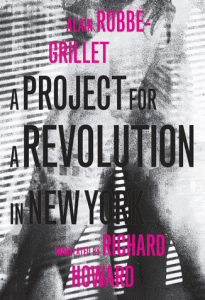 Project for a Revolution in New York
Project for a Revolution in New York
by Alain Robbe-Grillet
Dalkey Archive, September 2012
183 Pages / $14 (buy it on Amazon)
FRONT MATTER
1. I’ve read all of the fictional novels that Robbe-Grillet published in France between 1955 & 1981, albeit in English, some multiple times, others not. This leaves out only 4 novels proper–the first two (Un Regicide & The Erasers) and the last two (Repetition & A Sentimental Novel). Half of those remaining have yet to receive English translations. This was my second reading of Project for a Revolution in New York.
2. This quantifying, of course, does not include everything else that Robbe-Grillet wrote: a short story collection–Snapshots in English, of interest perhaps only as spelled out examples of the theory set forth in For a New Novel; three “romanesques”, being, for want of a better term, “creative non-fictional” memoirs (only the first of which, Ghosts in the Mirror, has been translated into English–which, admittedly, is a bit of a snooze-fest when compared to the purely fictional novels); thee essay collections, with, once again, only the earliest, For a New Novel, available in English (a really valid collection if one is tired of a standardized canonical/literary fiction); a handful of cine-novels–the earliest (Last Year at Marienbad & The Immortal One) once again being the only ones translated into English; and perhaps the most interesting part of Robbe-Grillet’s oeuvre, the ‘collaborative’ works that ultimately feed, intertextually, into my favorite of his novels, collaborative works with artists (Magritte, Rauschenberg, Johns) & photographers (Irina Ionesco, David Hamilton). And one must not forget his films, a necessary contingency of his body of work.
3. Due to my engagement–perhaps even, one could say, obsession– with Robbe-Grillet’s work, I’ve found it easier to split his published novels into a number of categories, guided by this website, which was one of the earliest strongholds of info on Robbe-Gillet on the internet when I began my obsession in 2004.
READ MORE >
March 13th, 2013 / 5:34 pm
Remembering AWP 2013 (Through Embedded Photos)
I took the Lucky Star bus to Boston with Andrew. A week or so earlier the Fung Wah bus, the bus I’d taken between Boston and New York for five years, had terminated operation by demand of federal government? (Did I read that wrong?) After a long, and delayed, transport, we made it to my parents’ house in Westborough, where we awoke the following morning to what would become 18 inches of snow.
We helped my parents shovel (my father worked the snowblower).
I’d had no intention of paying the registration fee, but things were kind of lax anyways? This is what the inside of the conference looked like.
Murder: An Interview with Nathanaël, Translator of Danielle Collobert
Forthcoming from Litmus Press this April, Nathanaël’s definitive English translation of Danielle Collobert’s Murder marks the first ever of this French poet’s debut book. Originally begun in 1960 when Collobert was twenty years old, and published by Gallimard in 1964 under the auspices of Oulipo-founder, Raymond Queneau, this book laid the groundwork for what remains one of the most enigmatic and innovative bodies of work in contemporary French letters. As with the subsequent works of Collobert’s brief but impactful output, which lasted until her suicide in 1978, Murder speaks a language profoundly its own, unlike anything else she was to write, and quite possibly unlike anything else you may have read. Reading this prose gives one the rare impression of being in the presence of a voice speaking from the honest and cutting edge of present urgencies: that is, this is not a voice responding to conventions or trends in literary necessity, but one singularly engaging the emergent necessities of life itself, in all its complexity and danger. Here, in honor of Danielle Collobert and this fantastic new translation, Nathanaël and I discuss her life and legacy with an eye on her first work, Murder.
***
 Murder
Murder
by Danielle Collobert / translated by Nathanaël
Litmus Press, April 2013
104 pages / $18 Buy from Litmus Press or SPD
Kit Schluter: To begin, what drew you to Danielle Collobert’s work? How did you discover it?
Nathanaël: I want to say that it was accidental, but I’m quite sure it wasn’t. Unless one understands friendship as accident. I entered, as did many, into Il donc, and Collobert’s Carnets, though with an eye turned away – perhaps out of a desire not to seek the life in the work, however much it is written there, and with such determinacy; the ‘twenty years of writing’ set against the impending suicide. Still, it is a hazard of hindsight to be able to set the life against the work, though this is so obviously a deformation of the reader, and so I resist as much as I can the tidy narrative of a life fallen from letters. The short answer to your first question is: Collobert’s language. But if the virtuosic remnants of Il donc are almost a perfect epitaph to the twenty years, I was much more viscerally and immediately impelled by Meurtre; I even borrowed an epigraph from this work into We Press Ourlseves Plainly much before the idea even of translating it had presented itself to me. Perhaps most immediately because of a shared concern, or conviction, that the distinction between murder and death is unconvincing and too readily upheld.
KS: What were the circumstances surrounding Danielle Collobert while she was composing Murder? Do you find that the book draws material or imagery from her experience?
N: My knowledge of Collobert’s biography is quite limited. Not unlike her parents and her aunt, who were all actively engaged in the Résistance during WWII, Collobert, a supporter of Algerian independence, was a member of the FLN (Algeria’s Front de libération national) at the time of Meurtre. She chose exile in Italy, where she completed work on the manuscript. It may be worth underscoring the importance of 1961, for the outcome of the war, which, in French contemporary society was never acknowledged under the name of anything other than the euphemistic “les évènements” (“the events” – to do otherwise would have been, not only to have acknowledged, if only semantically, Algeria’s nationhood, but the repressive force employed by France to resist – and as it happened, to defer – decolonization and independence). On October 17, 1961, a peaceful demonstration of many thousands of Algerians living in Paris, protesting the curfew imposed exclusively upon them, and the acts of police violence to which they were systematically subjected, was violently suppressed by Vichyist Maurice Papon’s police force, resulting in the arbitrary deportation of large numbers of Algerian demonstrators, and the summary execution of up to two hundred Algerians, many of whose bodies were pulled out of the Seine in the following days; several thousand Algerians were rounded up during the demonstration and distributed among prisons, the Palais des Sports and area hospitals. Several months later, on February 8th, 1962, what has come to be known as the Charonne Massacre took place at the eponymous Paris métro station; this demonstration, organized by the Left against the paramilitary OAS (the reactionary Organisation de l’armée secrète, which violently opposed Algerian independence), and often conflated in people’s memories (and in historical accounts) with the October massacre, resulted in the death of eight demonstrators at the Charonne métro station. It is not insignificant that French FLN supporter Jacques Panijel’s 1961 film, Octobre à Paris, which documents the moments before, during, and after the October demonstration, was censured by the French government and only shown for the first time in a French cinema in 2011 – half a century after it was made.
The photograph on the cover of Murder accounts, obliquely, and somewhat prochronistically, for these activities – it is a photograph of a bombed out building in Madrid, taken in 1937 by Robert Capa, during the Spanish Civil War.
Meurtre is tempered by the residues of such histories; but the work’s strength is in its ability to evoke them without resorting to explicit accounts, or naming. The generalization of historical violence is embedded in the intimate accounts presented to the reader – seemingly placeless, nameless, they nonetheless achieve historical exactitude through relentless repetition – a reiterative (mass) murder (one is tempted to say: execution), which afflicts and incriminates the gutted bodies that move painstakingly through these densely succinct pages.
25 Points: The Sounding Machine
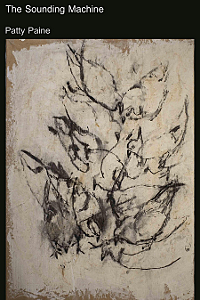 The Sounding Machine
The Sounding Machine
by Patty Paine
Accents Publishing, 2012
71 pages / $12.00 buy from Accents Publishing
1. “Still” is a poem about a girl, in her stepfather’s bedroom, holding the “unspooled” film of frames showing “Linda Lovelace’s bottomless / throat” against “curtained light.”
2. The girl’s ears are “cocked / for gravel beneath tires.”
3. She is afraid that her stepfather will return, angry.
4. “Still” is a poem about abuse, and how the memory of that abuse is wrapped and “swallowed” like the “first flash of desire”; that “chasm / of silence, her mouth.”
5. “Still” is not the first poem of The Sounding Machine, but the one I returned to the most. Paine’s collection accumulates, but “Still” is the best pivot.
6. The Sounding Machine hurts.
7. This is a book about grief, focused on the loss of a mother. So Nyo Kim. A woman who married an American soldier during the Korean War. The narrator of many poems in this collection–apparently So Nyo’s daughter–is nearly peeling with this grief.
8. “Sometimes I stop looking/ in mirrors.” “Sometimes I feel / like a child with holes / in my pockets, every day losing / some small stone of myself.”
9. The Sounding Machine made me feel, but Paine was also able to control me, to wire me shut with words. “Ars Poetica” warns that “there are days / when language is heavy furniture you push around / a house made of nothing / but hallways.” The narrator admits “sometimes a poem can lie.”
10. But I want to believe her lies. READ MORE >
March 12th, 2013 / 1:30 pm
Any thoughts on the new Bowie album? I’m halfway through and “Where Are We Now?” and “Valentine’s Day” at least seem decent?


